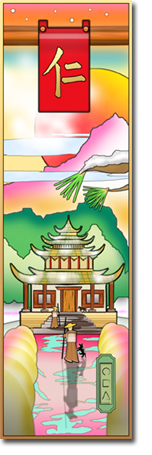On The Way: The Daily Zen Journal
Other Ways to do Zen
Chih-I (538-597)

Understand, you who practice “Stop” “Look” Zen, that we must face conditional causes when we encounter the external world outside of meditation. Though sitting in the upright position is the very best way to perfect your body, there are innumerable occasions when you must get bodily involved in the things and conditions of the worldly.
If you have not practiced and perfected “Stop” “Look” (Samatha Vipasyana), then the opportunities to improve your heart-mind will be limited to meditation.
Attachment to karmic deeds will arise as you encounter external things. How can you hasten to respond to them in the Buddhist way? If you can at all times, with constancy, practice the upaya skills of samadhi concentration and wisdom, you must be aware that by doing so, you can attain all of the Buddha’s teachings.
What does it mean to practice “Stop” “Look” Zen while passing through worldly causes and conditions? There are six conditions in which you can practice: walking, standing, sitting, lying down, doing work, and talking.
What is meant by “practicing Samatha Stopping and Vipasyana looking according to external circumstances?” There are six kinds of worldly circumstances: the eyes look at colors (sensual attractions); the ears hear sound; the nose smells; the tongue tastes; the body feels by touch; and the mind conceptualizes images (Dharma). You the practitioner can perfect “Stop” “Look” meditation in all twelve of these external circumstances. Thus it is called “Perfecting Samatha Vipasyana while encountering the external world.”

As for the first, “walking” or going somewhere, while walking there you should think “for what reason do I want to go there, and what desire moves me?” If the reason is not done out of compassion and the affair itself is of no account, then there is no need to go.
If the motive is compassion, and there is more than ordinary benefit to going, and it is a deed in keeping with the Buddhist way (Dharma), then you should go. What is the meaning of practicing Samatha (“stop” meditation) while walking?”
If while walking you put an end to all judgmental thoughts, and due to centering on the act of walking itself, of all the good and evil thoughts that arise, there isn’t one that you focus on, with the result that delusory thoughts do not arise, this is called practicing Samatha while walking.

What does it mean to practice Vipasyana (Look meditation) while walking? To do this you must when walking think about the fact that the will causes the body to move, and that going out and coming back are due to this (the mind’s judgment and will’s desire). Therefore, all good and bad Dharma (thoughts) that arise, are called “karmic deeds.”
You must now reflect inwardly on the heart-mind, while walking. Inside the heart-mind itself there are no images or appearances to be seen. You the walking person must now be aware that all Dharmas (concepts envisioned in the mind) are in the long run empty and isolated from reality. This is what is called practicing Vipasyana looking while walking. Thus while walking you can practice Samatha Vipasyana “Stop” “Look” meditation as was described above.

Second, it is possible to practice “Stop” “Look” meditation while standing or staying in some place. To do this you must ask yourself when staying in some place “why am I staying here and to fulfill what purpose do I desire to be here?” If it is not a compassionate deed or a thing worth noting, then you should not stay there. But if you do a deed out of compassion with extraordinary benefit, then you should stay.
Why is this called practicing Samatha “Stop” meditation while staying somewhere? If while you are staying there you cut off all judgmental thoughts, knowing that due to staying there all sorts of good and bad Dharma thoughts will arise but due to not holding onto these images not one of them will give rise to false or illusory thoughts, then such a practice is called “Samatha” (stopping images and judgments).

How does one practice Vipasyana (“Look” meditation) while staying somewhere? While doing this deed (stopping somewhere) you should think that it is due to the mind and will that movement is controlled and managed, making the body stop and stay somewhere. Due to this all sorts of good and bad Dharma images will arise, due to your “staying.”
Now look at your heart-mind as it is staying here. The heart-mind is of itself without form or image. You must realize that all Dharma images that arise in the mind are also in the final count empty and isolated from reality. This is “practicing Vipasyana looking.” You can also practice wisdom meditation as was explained above in “walking.”
Excerpted from Zen Is for Everyone: The Xiao Zhi Guan Text by Zhi Yi trans by Michael Saso 2001





This piece taken from the Little Manual of Samatha Vipasyana Meditation covers one of the most challenging points in practice: how to bring awareness into daily activities. What process or technique has been recommended or taught? In reality, very few masters in the past spoke directly about this stage of practice, leaving its discovery up to the students.
It is an issue that comes up early for the new meditator. Sitting meditation is practice enough in the beginning and raises its own questions, but with time the mind settles itself and the breathing returns to its own natural state.
We are told to return to the world from meditation slowly and to attempt to extend the awareness into daily life. However, quickly, one is drawn into the distractions of daily life, and one notices being lost in a “doing” state of mind, or notices a word that comes out mechanically and sometimes a thought is unkind.
With that noticing comes the opportunity to return to equanimity before thoughts and reactions occur. It feels very much like balancing between extremes and is akin to the rocking back and forth and side to side finding one’s center before settling into meditation.
The practice of compassion balanced with wisdom is what we aspire to, so the suggestion to ask oneself the question of what is driving the current action is reasonable as a technique to begin with. However, there are many ways to personalize this, and perhaps a word that resonates with you in particular will be more useful.
At any rate, this is a good beginning, as bringing this all to life each day takes a constant awareness, no matter how long you have trained. And it calls to mind what exactly are our priorities each day. How will you make this a living experience?
Looking out at the blue sky,
Elana Scribe for Daily Zen